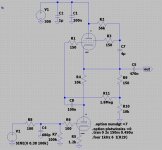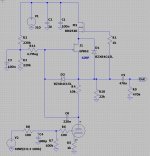I have lurking suspicion that the current source load represented by the upper half of the srpp will result in severe dc instability as both the pentode and the srpp are going to try and set the plate current, yet it may work since triodes in srpp usually make fairly mediocre current sources.. Were this an AC amplifier I would suggest a gyrator, but since it is not.. What I might suggest is using fixed grid bias (battery) on the SRPP with a bigger cathode resistor to get as high of an effective plate load as you can manage.
I saw this solution in the Valley Wallman book, at page 439, it is interesting. What I don't be sure is, if I took the output directly from the triode´s cathode, is also a low impedance point. I believe it is so.
I would say the best approach might be to build a test jig and measure the transconductance for a variety of different screen voltages. (I use my utracer for just this sort of thing.)
This isn't by the moment a problem, the amplifier will be severely bandwidth restricted, so the risk of instability or oscillation, in a first time, don't care. In fact, I managed the possibility of positive feedback the amplifier to make the 1 + AB in the denominator of the closed loop amplification, vanishes and get almost infinite gain from a normal tube in normal operation conditions, thing that was used and explained clearly in the above mentioned book, in page 475 and followings.
See attachment, and I expect it will be most unstable, but it should allow you to realize ridiculous gain levels with a moderately high transconductance triode if you can get it at all stable or place it inside a DC feedback loop. You can also do strange things like deliberately mismatch the currents between the srpp (set slightly higher) and shunt some of that current through a large resistance in parallel with the pentode to gnd, the pentode takes what it needs to satisfy its op point, and the rest goes to the resistor as plate voltage rises until the current delivered by the srpp is all consumed. I expect you can still get a very healthy gain this way and run at quite high plate currents to get the transconductance up. This might actually work ok if you have plenty of supply headroom.
Many thanks to you for the input to the thread.
Last edited:
This is a old thread but why not activate it again. Oke, I have design a mu stage with a pcl 86 I have set the penthode and triode section on .25 procent of max dissipation as I did read about this mustages.
I have the PCL 86 who is a ecc83 and a el86 in one.
Setting EL86 section to 15 ma is 0.25 of max dissipation, so I want to ask, because now R10 become quite low (10K) EL86 is maybe to big for this task.
I use it as a CCS. I have also a mosfet version, but the capacitances are a really problem, and give more distortions, however using a mosfet/Jfet does let make
things much better.
Some advice welcome.
thanks.
I have the PCL 86 who is a ecc83 and a el86 in one.
Setting EL86 section to 15 ma is 0.25 of max dissipation, so I want to ask, because now R10 become quite low (10K) EL86 is maybe to big for this task.
I use it as a CCS. I have also a mosfet version, but the capacitances are a really problem, and give more distortions, however using a mosfet/Jfet does let make
things much better.
Some advice welcome.
thanks.
Attachments
This is not a problem, I go try what it does, with it we have a simple compact mu-stage preamp.The pentode section (or in reality: the beam power tube section) in the ECL86/PCL86 is not (almost) equivalent to the EL86 (of which the P-version is the PL84). It is however practically equivalent to the EL41 (which is a true power pentode).
Here is my working "ultra high gain" 4 watt guitar amp design. The input stage is a pentode mosfet pair with it's gain controlled by a 2 meg pot, essentially in the same place where you have a 4.7 meg resistor. Electrically it works great. The real issue becomes microphonics as the gain pot is increased. Somewhere around half throttle the amp becomes microphonic enough to start an acoustic feedback path with the nearby speaker cabinet. Every tube is different, some are worse than others. A new tube will get worse over time if it is subject to vibration, especially if the amp head sits on top of the speaker. The 18FW6 is just a 6AU6 with an 18 volt 100 mA heater.
Attachments
- Home
- Amplifiers
- Tubes / Valves
- Pentode's screen voltage/current

